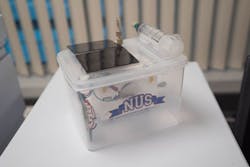Photosynthesis-like Method Makes Ethylene
With world ethylene demand expected to exceed 220 million metric tons/y by 2020, the search is on for new manufacturing methods to replace the energy-intensive, high-carbon-footprint cracking processes favored today. A team of scientists at the National University of Singapore (NUS) believe they have an alternative with their prototype device that mimics natural photosynthesis and works at room temperature and pressure to produce ethylene gas using only sunlight, water and carbon dioxide.
The work is being led by assistant professor Jason Boon Siang Yeo of the department of chemistry at NUS and the Solar Energy Research Institute of Singapore (SERIS).
Yeo and his team started in 2015 first designing a copper catalyst that could generate ethylene from readily available water and carbon dioxide when powered by electricity.
Figure 1. Solar-powered reaction of water and carbon dioxide to make methanol proceeds at ambient temperature and pressure. Source: National University of Singapore.
The team subsequently introduced this copper catalyst into an artificial photosynthesis system to convert carbon dioxide and water into ethylene using only solar energy. They designed a prototype device, which measures 15 cm × 25cm × 40cm, (Figure 1), to carry out the reaction, and achieved a 30% faradaic efficiency of ethylene based on the amount of electrons generated from solar energy — the same efficiency as photosynthesis.
However, this stage wasn’t without its challenges. “First, we optimized the efficiency of the cell by modifying its configuration and by improving the iridium oxide anode and the potassium hydrogen carbonate electrolyte. Then, we tested out different solar panels to achieve a best match between solar panels and our cell. Once the stability of the cell was optimized, we introduced a custom-built circuit for the continuous production of ethylene day and night, with solar radiation as the only energy input,” explains Yeo.
[callToAction ]
The team now is working on scaling up their device for ethylene as well as using similar systems to produce liquid fuels such as ethanol and propanol.
Scale-up is focusing on two main areas: increasing the surface area of the electrode and the size of the cell, and designing a new cell that includes a gas diffusion electrode to achieve a higher reaction rate per surface area.
“Some of the technical challenges that need to be overcome are to develop an earth-abundant alternative catalyst to replace expensive iridium used in the anode, and to increase the working stability of the catalyst,” he adds.
The work has attracted interest from the chemical industry, says Yeo, who declines to reveal details.

